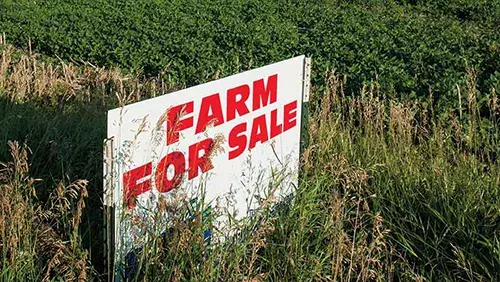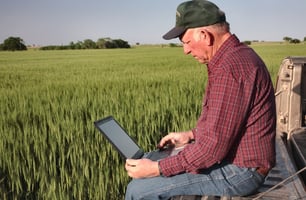AgWeb’s Margy Eckelkamp reported recently that “family farms still dominate a majority of U.S....
Where Is Farmland Going?

A look at what is happening to American farmland as farmers get older.
When Ray Gaesser watches land auctions near his Corning, Iowa farm, he sees a growing share —up to 25% — of ground going to investors. Local buyers still make top bids on more parcels, the smaller ones.
“The larger farms, investors tend to buy those,” Grasser says. “It takes a lot of money to buy 500 acres at $12,000 an acre.”
He’s not a buyer. “The last few years, it didn’t pencil out,” he says. Gaesser, 71, and his wife, Elaine, have shifted 88% of their 5,000-acre operation to their son, Chris, and his wife, Shannon. The family rents about four-fifths of their farm that grows corn, soybeans, and rye.
Gaesser’s observations and decisions mirror a demographic shift in who owns and runs America’s farms. Experts see a “gray wave” rolling toward the land market. Like Gaesser, they are finding more investor interest in a supply still tightly held by families and heirs. And it’s a supply made even tighter by urban encroachment.
American Farmland Trust (AFT), a nonprofit working to conserve farmland, expects 300 million acres of U.S. agricultural land to change hands in the next 20 years. That’s more than a third of some 880 million acres of farm and ranch land in the lower 48 states. The group’s analysis of the USDA’s Census of Agriculture and the USDA’s 2015 land tenure report shows upwards of 40% of farmland is owned by people over 65.
From 2001 to 2016, the nation lost 11 million acres of farmland to urban sprawl, says Sam Smidt, who leads land use research at AFT. The group expects 18.4 million acres to disappear by 2040.
“Farm land loss isn’t rapid, but it’s continuous,” Smidt says. “Nor is it limited to coastal areas with large population growth. Rural states with top-quality land, such as Kansas and Iowa, also are losing ground.”
“One of the reasons farmland gets converted is that it’s easy to develop,” Smidt says.
Besides promoting land protection policies, AFT supports food production by family farmers. At first glance, that popular goal, too, seems threatened — by foreign and domestic investors.
When a Chinese company bought 300 acres near a North Dakota air force base, calls for more restrictions on foreign ownership grew among elected officials. The USDA reported that foreigners own more than 40 million acres, about 3% of U.S. agricultural land. The biggest investors turned out to be Canadians. A flurry of investigations by reporters and scholars showed the threat might be exaggerated.
Journalists also unearthed domestic billionaire buyers. Last year, Flatwater Free Press, a nonprofit news organization in Nebraska, reported that Microsoft founder Bill Gates was among them. “Seven out-of-state buyers, including a Utah church, a Philadelphia corporate farm, and a California investment fund, spent nearly $250 million in the past five years on pricey Nebraska farmland,” the report said.
Who’s Buying?
Beyond the headlines, land ownership changes are less dramatic.
“Seventy percent of the land that we sell goes to farmers,” says Steve Bruere, President of Peoples Co., which brokers and auctions land in more than 30 states.
“At the end of the day, people are passing their land on to kids and grandkids or relatives,” Bruere says, adding that only 1% or 2% of all farmland hits the open market annually. Even as owners age, Bruere doesn’t envision larger swaths of land becoming suddenly available. “I feel like it’s going to move up and maybe might be 3%, but it’s not going to be 5%,” he says.
Bruere’s hunch is backed by an Iowa State University (ISU) report, “Iowa Farmland Ownership and Tenure Survey 1982–2022: a Forty-Year Perspective.” During that time, players have aged. As of 2022, people 65 or older owned two-thirds of the state’s farmland; those 75 and up held 37%. In 1982, only 29% were 65-plus.
The Iowa report is one of the best. “If you use Iowa as a proxy for national trends, it’s pretty solid,” Bruere says.
Family and Heirs Benefit the Most
Over decades, ownership types and rental agreements changed. More land became absentee owned. Yet, owners plan to sell most of their land to family members or put it in trusts, likely for heirs. In 2022, only 4% of all owners planned to “sell to others,” according to the ISU survey. That’s similar to the upper range Bruere expects for public sales. He expects more investor buying, but also not in a big wave.
The total value of land owned by big institutional investors — pensions, insurance companies, and others — is $16 billion, according to the National Council of Real Estate Investment Fiduciaries. That’s about a half-percent of the $3.4 trillion value (USDA estimate) of all U.S. farmland.
The investor share of the market will grow because larger farms won’t tie up too much money in land, Bruere says: “It’s just a reality. The capital it takes to farm and the capital it takes to buy farmland, you can’t do it all.”
Curt Covington, senior director of managed accounts at the lender AgAmerica, agrees with Bruere. Some farms are already selling off poorer-quality land in the face of falling commodity prices, he says.
“I think many of those farm operations are seeing tougher times and they’re hunkering down,” Covington says. For similar reasons, investors are less active.
What does this mean for farming’s next generation? A tough row to hoe for those without family help.
“The young and beginning small farmer programs aren’t robust enough to deal with how rapidly land costs have gone up,” Covington says.
At AFT, which sees young farmers as a bulwark against urban encroachment, Erica Goodman notes fewer successful transitions on smaller farms.
“You’re not seeing as many of those sustained across generations,” says Goodman, the group’s Farms for a New Generation director. “For the exiting generation, it can be a grieving process or a sense of failure that they don’t have someone to take over that land.”
AFT runs a linking program with New York state that matches retiring landowners with unrelated would-be farmers. AFT is also helping Indiana University’s Land Access Policy Incentives project to research state programs such as tax incentives for owners selling to beginners.
Gaesser hopes for more generational transfers and ones that foster resource conservation. “Do you want your local community to be successful? If you do, we need families out here,” he says.
EDITOR’S TAKE:
This article suggests that farmland, in large part, is still being controlled by farm families. However, there is continued concern over foreign ownership and large outside investors. The next few years will see a huge transfer of farmland from the current generation of owners to new owners. Whether that land remains in the family or is transferred to outside ownership will be watched very closely by government officials and bankers who lend money to farmers/ranchers. My personal bet – a very high percentage will remain in the hands of family farms/ranches. After all, they depend on it for not only their living but the equity they need to secure operating loans. Plus, no one will take better care of that land than the farm/ranch family who owns it. Therefore, continue to look at farmers and ranchers in your area as key customer prospects today and well into the future!








